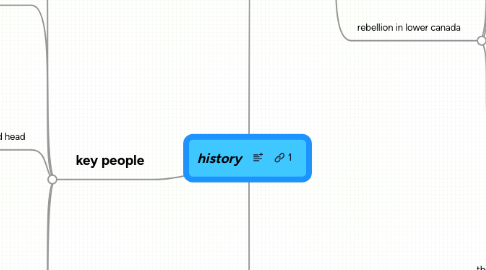
1. key people
1.1. lord durham
1.1.1. backround
1.1.1.1. british
1.1.1.2. 46 years old when he came to Quebec
1.1.2. achievements
1.1.2.1. he held meetings with individuals and groups to figure out the opinion of the citizens
1.1.3. significance
1.1.3.1. was sent to lower and upper canada to
1.1.3.1.1. to find out why there were rebellions
1.1.3.1.2. to make a report and recommendations to avoid future violence
1.2. William Lyon Mackenzie
1.2.1. backround
1.2.1.1. scotish
1.2.2. achievements
1.2.3. significance
1.3. sir francis bond head
1.3.1. backround
1.3.1.1. was a solider for Britain and retired as a major
1.3.1.2. spent some years for a mining company as an engineer
1.3.2. achievements
1.3.2.1. was lieutenant-governor of upper Canada
1.3.2.2. shut down an election and calling a new one
1.3.3. significance
1.4. louis-joseph papineau
1.4.1. backround
1.4.1.1. father was a seineur
1.4.1.2. born in Montreal
1.4.1.3. studied to be lawyer but became intrested in politics
1.4.2. achievements
1.4.2.1. supported reform
1.4.2.2. published the ninety-two resolutions
1.4.2.3. at first supported the violence but when it became clear they will lose he fled to U.S
1.4.3. significance
1.4.3.1. was the voice of moderate reform
1.4.3.2. died in 1871
1.5. Robert Baldwin and Louis- Hippolyte LaFontaine
1.5.1. they both believed that making minor changes were good enough
1.5.2. they wanted responsible goverment
2. conflict
2.1. rebellion in upper Canada
2.1.1. Montgomery's tavern
2.1.1.1. Mackenzie rebels meet together
2.1.1.2. bond heads troops fight of the rebels
2.1.1.3. Mackenzie's key supporters Samuel Lount and Peter Matthews were hanged
2.1.2. Mackenzie noticed the rebellions in lower Canada and wanted to change upper Canada so he started the rebellion
2.1.3. Mackenzie's army were farmers workers and unemployed people
2.1.4. they didn't have much people so Mackenzie waited for more to come. this gave bond head more time to prepare
2.2. rebellion in lower canada
2.2.1. battle of saint Denis and saint Charles
2.2.1.1. armed patriote supporters capture a seigneur's manor
2.2.1.2. an army commanded by Lt. colonel Francis Gore
2.2.2. battle of saint Eustache
2.2.2.1. the commander of the British army in North america at the time was sir John Colborne
2.2.2.1.1. he led a force of 1200 well armed men
2.2.2.2. the rebels tried to defend themselves by hiding in churches
2.2.2.3. about 100 rebels were killed and many more were taken prisoners
2.2.3. hunter lodge
2.2.3.1. many Americans near the border thought the rebellions would lead to the defeat of the British so they helped them
2.2.3.2. rebels who fled to the U.S started to organize groups
2.2.3.2.1. in upper Canada these groups were called hunters' louges
2.2.3.2.2. in lower Canada these were called Freres Chasseurs
2.2.3.3. by mid 1838 there were 40 000 to 60 000 members
2.2.3.4. they tried to invade but they were defeated at Windsor and Prescott in upper Canada and Napierville, Lacolle and Odelltown in lower Canada
3. change
3.1. russel resolutions
3.1.1. these were the response for the 92 resolutions
3.2. lord Durham's report
3.2.1. lord Durham gave suggestions to the British
3.3. Papineau's nighty-two resolutions
3.3.1. these were the the wishes that the reformers from lower canada wanted that Papineau published
3.4. union act
3.4.1. Canadas are now named canada east and canada west capitals are Kingston in canada west and then montreal
3.4.2. there will be equal representatives. each Province get 65 representatives
3.4.3. was in play for 26 years
3.5. british north america act
3.5.1. British north america act replaced the union act. it created the canadian confederation which created Canada
